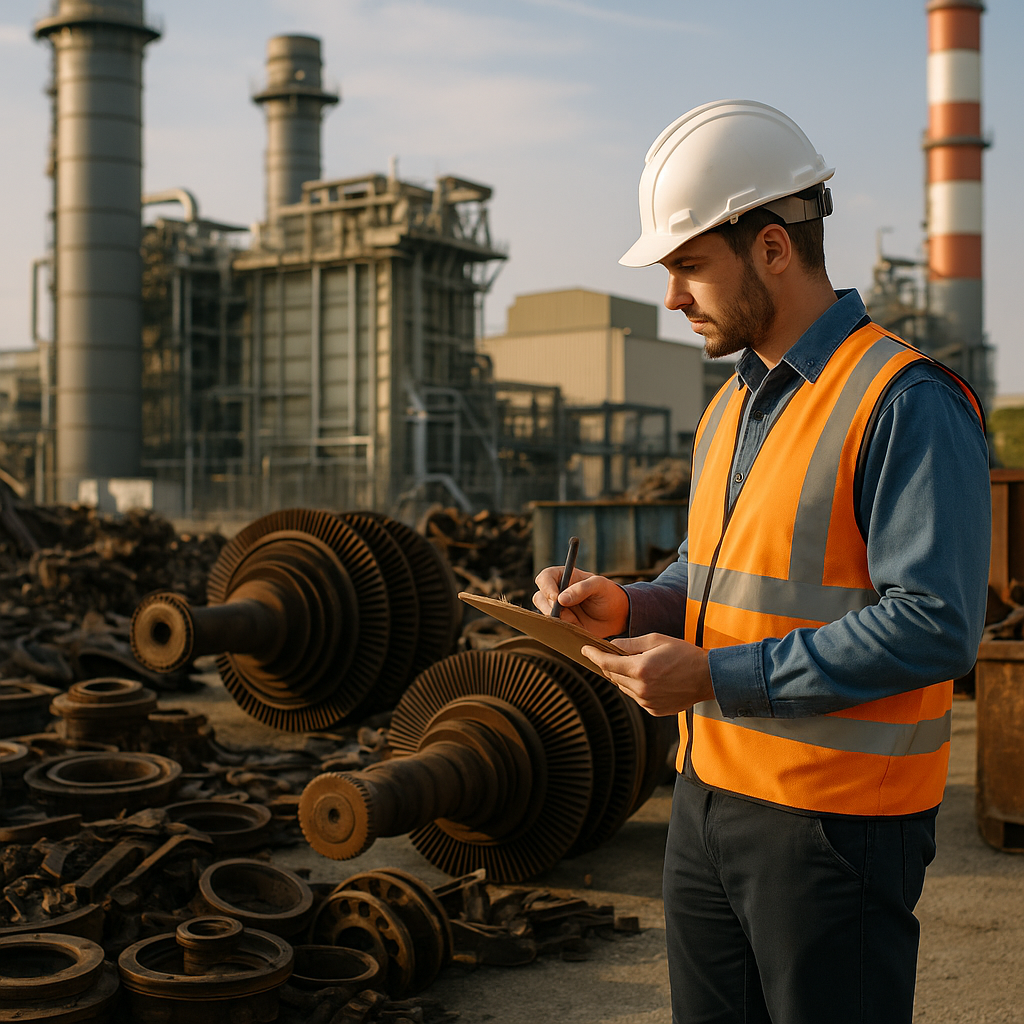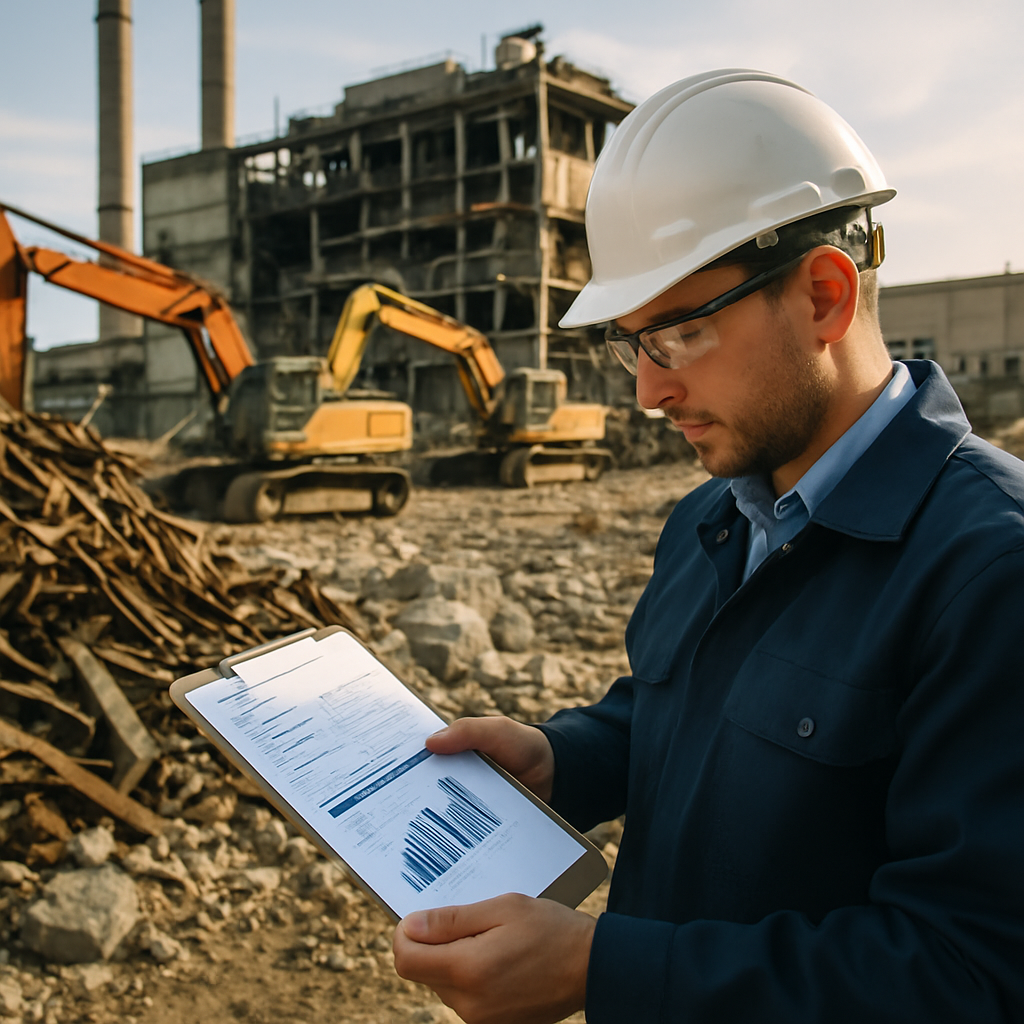5901 Botham Jean Blvd, Dallas, TX 75215
What is the Scrap Value of a Decommissioned Power Plant?
July 30, 2025When power plants reach the end of their operational life, they still possess significant value through their materials and components. The scrap value of a decommissioned power plant represents the monetary worth of salvageable materials reclaimable after a facility shuts down. This value isn’t merely a minor benefit—it can substantially offset the costs associated with decommissioning, which often amount to millions of dollars.
Steel components are fundamental to most power plants, forming structural elements and equipment casings. Copper, abundantly found in wiring, transformers, and generators, commands premium prices in recycling markets. Aluminum components also contribute to the overall salvage value. The combined value of these metals can be considerable. In some decommissioning projects, salvage values can recover more than half the dismantling costs, particularly in wind farms where steel towers contain hundreds of tons of recyclable metal.
Several factors influence the final scrap value calculation. The size and type of the power plant play a major role—larger facilities typically contain more recoverable materials. Equipment specifications matter as well, as different plant technologies incorporate varying amounts of valuable metals. Market conditions introduce another variable, as scrap metal prices fluctuate based on global supply and demand. For example, steel scrap prices have ranged from lows near $100 per ton to highs exceeding $400 per ton in recent years, creating significant variation in potential recovery values.
How is Scrap Value Calculated for Power Plants?

Calculating the scrap value of a power plant requires a systematic approach to determine the worth of recoverable materials once the facility reaches the end of its operational life. Power plants contain substantial amounts of valuable metals that can be salvaged during decommissioning.
The fundamental formula for calculating scrap value is straightforward: subtract the disposal and transportation costs from the total revenue obtained by selling recoverable materials. However, the actual calculation process involves several detailed steps.
Step-by-Step Scrap Value Calculation Process
The first step is conducting a comprehensive inventory of all recoverable materials. For power plants, this typically includes:
- Steel from structural components, support towers, and equipment frames
- Copper from wiring, transformers, and generators
- Aluminum from various components and housing
- Other valuable metals such as brass or stainless steel from specialized equipment
Next, engineers estimate the weight of each material type, requiring detailed knowledge of power plant components and possibly consulting original construction specifications. For example, a typical coal power plant might contain several thousand tons of steel and hundreds of tons of copper.
Current market prices for each material must then be determined. Scrap metal prices fluctuate considerably based on market conditions, so many professional assessments use average prices over a set period to account for volatility. For instance, recent industry studies have used benchmark prices such as carbon steel at $166-300 per ton and copper at $3,220-5,000 per ton.
Factoring in Costs and Deductions
The gross scrap value must be adjusted for various costs involved in the recovery process:
- Transportation costs to processing facilities or scrap yards
- Labor costs for dismantling and separating materials
- Processing costs for preparing materials for recycling
- Disposal fees for non-recyclable components
Transportation often represents a significant expense. In professional decommissioning studies, transportation assumptions might include specifications like “hauling cost of $13 per cubic yard based on a 40-cubic yard capacity truck making a 65-mile one-way trip.”
Additionally, deductions are applied to account for material processing. Mill-delivered prices are typically reduced to reflect the costs of transportation to processors, separation, preparation, and shipping to mills.
Professional Assessment Methods
Professional decommissioning studies use sophisticated methodologies to calculate scrap value. These assessments often employ:
1. Bill of quantities analysis that identifies all recoverable materials
2. Material weight estimations based on technical specifications
3. Current market pricing research with conservative projections
4. Detailed cost modeling for all aspects of material recovery
For large facilities like power plants, these studies typically present multiple scenarios. For example, a comprehensive decommissioning analysis might show both a “no resale” scenario (where everything is sold as scrap) and a “partial resale” scenario (where some components are sold as functional units rather than just for material value).
The resulting net salvage value can vary widely depending on the plant type, age, and market conditions. For instance, a professional study of an 11 MW solar plant found that scrap metal offsets approximately one quarter of the total cost of plant decommissioning.
Market Volatility Considerations
Given the long operational life of most power plants (often 20-30 years), current calculations can only provide estimates of future scrap value. Best practices include periodic reassessment of decommissioning costs and potential salvage values, particularly as the facility approaches the end of its operational life.
Many plant owners conduct updated scrap value assessments 2-4 years before planned decommissioning to obtain more accurate projections based on current market conditions.
By thoroughly assessing recoverable materials, current market prices, and associated costs, power plant operators can develop realistic expectations for the scrap value of their facilities. This information is crucial for financial planning, regulatory compliance, and determining the most economical approach to decommissioning.
What Factors Influence the Scrap Value of a Power Plant?

The scrap value of a decommissioned power plant is a crucial financial consideration in the decommissioning process. This value can offset demolition and remediation costs significantly, sometimes by up to 50% in wind facilities or 25% in conventional power plants. Understanding the factors influencing scrap value helps owners make accurate financial projections and maximize recovery.
Plant type determines the quantity and types of salvageable materials. Coal plants often contain substantial amounts of carbon steel and copper, while natural gas facilities generally have less metal but more specialized equipment. Wind turbines offer particularly valuable materials, with each 200-ton turbine tower potentially yielding significant steel scrap. A 215 MW wind farm with 109 towers could generate between $3.3 million and $5.1 million in steel scrap value, depending on market conditions.
Market prices for recyclable metals exhibit extreme volatility, creating financial uncertainty. Steel scrap prices, for instance, have fluctuated between $100 and $400 per ton in recent years. This volatility means the same quantity of materials could differ in value by millions of dollars depending on when decommissioning occurs. For example, the difference between high and low steel prices could equate to a $6.5 million swing in salvage value for a single large wind farm.
The geographical location of a power plant impacts net scrap value through transportation costs. Facilities in remote areas face higher hauling expenses to reach major recycling markets. The distance to processing facilities directly influences these costs. A study comparing two hypothetical 150 MW offshore wind farms demonstrated this impact, with the facility farther from serviceable ports costing about twice as much to decommission per megawatt.
Age and condition of equipment are critical factors. Older facilities often contain materials like asbestos, PCBs, and lead paint that require specialized handling before salvage. These contaminants can significantly reduce the net value of otherwise recyclable materials. Newer facilities typically contain fewer hazardous materials and have modern equipment that might retain resale value beyond just scrap.
Environmental regulations also influence what materials can be salvaged and how they must be processed. Regulations under the Resource Conservation and Recovery Act have impacted coal combustion residuals management, requiring extensive remediation and monitoring. Solar panels contain cadmium, lead, and selenium, facing similar regulatory challenges for recycling or disposal.
The expertise of the decommissioning team in identifying salvage opportunities can dramatically affect recovery value. Professionals understand how to efficiently dismantle equipment to maximize recyclable components and identify reusable systems. For instance, in the repowering of the Altamont Pass wind farm in California, specialists replaced approximately 1,500 smaller turbines with 82 larger units, maintaining power output and recycling original equipment.
Contractual arrangements also influence realized scrap value. Some decommissioning contracts specify that plant owners share in scrap recovery proceeds, while others allow contractors to retain all salvage value in exchange for lower demolition costs. Clear contractual terms regarding salvaged materials ownership are essential for accurate financial planning.
Direct equipment resale rather than scrap recycling should not be overlooked. In some cases, especially with newer plants, certain components may have significant value in secondary markets. Turbines, transformers, and control systems might be sold to smaller operators or developing markets where new equipment costs are prohibitive.
Understanding these factors helps power plant owners make informed decisions about decommissioning timing and approach. While scrap value can substantially offset costs, its variability requires careful planning and possibly financial hedging strategies to manage risk effectively.
| Factor | Description |
|---|---|
| Plant Type | Determines quantity and type of salvageable materials; e.g., coal plants have steel and copper, while wind turbines provide steel towers. |
| Market Prices | Volatility in metal prices can lead to variance in scrap value; e.g., steel prices range from $100 to $400 per ton. |
| Geographical Location | Impacts net scrap value through transportation costs; remote areas incur higher expenses. |
| Age and Condition | Older facilities contain hazardous materials, while newer ones have modern equipment with potential resale value. |
| Environmental Regulations | Regulations affect salvageable materials; stricter rules may limit recovery. |
| Decommissioning Expertise | Experience in identifying recyclable components and direct resale opportunities maximizes recovery. |
| Contractual Arrangements | Contracts may affect who retains scrap value and impact overall costs. |
| Potential for Resale | Valuable newer components can be resold rather than scrapped. |
How Does Scrap Value Affect Overall Decommissioning Costs?

Scrap value significantly offsets financial expenses in power plant decommissioning projects. The salvage value from materials like steel, copper, and other metals can notably reduce overall decommissioning costs. Industry analysis shows that for coal-fired facilities, salvage value can be substantial.
The relative cost impact is noteworthy in decommissioning financials. Compared to the high expenses of retrofitting outdated plants ($700/KW) or building new gas-fired facilities ($900/KW), decommissioning costs are more modest at around $10/KW plus remediation costs, further reduced by salvage value. In some cases, the scrap value alone may completely cover demolition expenses.
For utility companies with aging infrastructure, this economic reality prompts strategic considerations. Metal-rich facilities often yield the highest salvage returns, with some plants seeing up to 25% of their total decommissioning costs offset by scrap value. This percentage varies based on facility type, construction materials, and current recycled metal market conditions.
Economic calculations become more favorable when considering ongoing costs of maintaining mothballed facilities. Expenses for security, environmental compliance, management, and taxes continue to accumulate for non-operational plants. Even when these outdated facilities operate as peaking units during high demand periods, the operating costs often outweigh financial benefits.
Market conditions play a crucial role in determining actual salvage returns. Metal prices, which fluctuate based on global supply and demand, directly impact the financial equation for decommissioning projects. Plant operators must monitor these markets closely when planning decommissioning timelines to maximize potential returns.
Financial planning extends beyond immediate cost recovery. The decommissioning process requires careful sequencing and resource allocation. Competitive power generators and regulated utilities often incorporate potential scrap value into financial forecasts, using these projections to determine optimal timing for facility closure and demolition.
Site repurposing opportunities add another dimension to the financial equation. When salvage value offsets demolition costs, utility companies can more readily clear sites for redevelopment. This creates opportunities to install newer, more efficient generation capacity at existing locations with established transmission infrastructure.
The potential for significant salvage value can accelerate decommissioning decisions. Rather than maintaining obsolete facilities indefinitely, operators recognize that recovering valuable materials represents a partial return on their initial investment while eliminating ongoing maintenance expenses.
Regulatory compliance factors into these decisions as well. As environmental regulations become more stringent, retrofitting older plants becomes increasingly costly. When compliance costs are assessed against decommissioning expenses minus potential salvage value, the financial case for decommissioning often becomes more compelling.
Conclusion: Maximizing Value in Power Plant Decommissioning

The scrap value of a decommissioned power plant is a significant financial component in facility closure economics. Properly managing salvage value can substantially offset decommissioning costs, which often reach into the millions. This is especially relevant for coal and natural gas plants, where scrap metal from turbines, boilers, and other components can recover up to 20-30% of total project expenses.
Maximizing recovery value requires strategic planning and market awareness. Decommissioning specialists who track metal price fluctuations, understand regulatory requirements, and use current recycling technologies achieve better financial outcomes. The volatile nature of scrap metal markets means timing can significantly impact returns, with steel prices alone fluctuating between $100 and $400 per ton in recent years. For large facilities containing thousands of tons of recyclable materials, these price swings can mean potential differences of millions of dollars in recovery value.
For professional guidance on maximizing the value of retired power generation assets, contact Okon Recycling at 214-717-4083. Our team of experts can help navigate the complex decommissioning process while ensuring optimal financial returns and environmental compliance.
